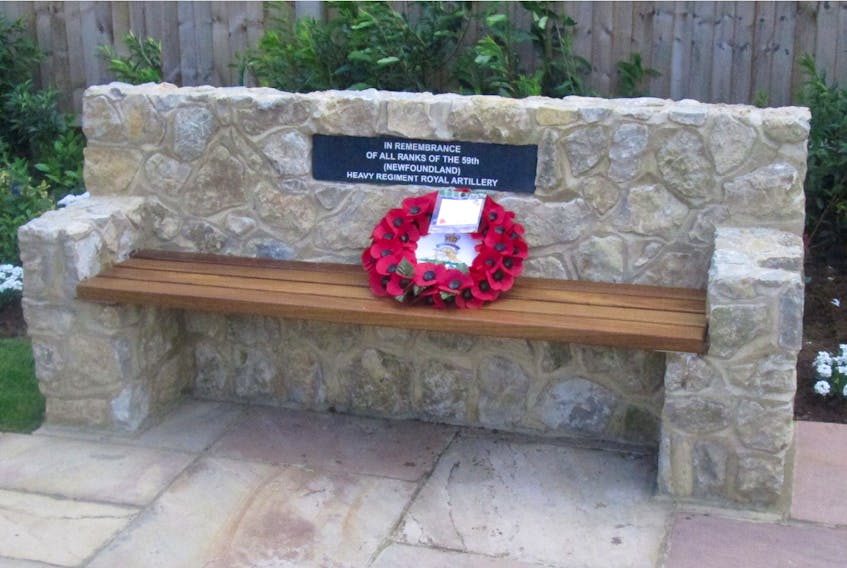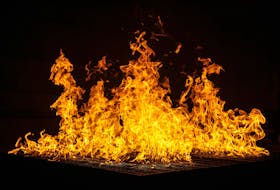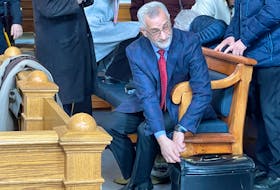Among the war graves of British Second World War soldiers at Bybrook cemetery in Ashford, Kent, United Kingdom, lies the grave of Newfoundland soldier Walter Kitchener Pike.

Pike was a gunner in the Royal Artillery, 59 (Newfoundland) Heavy Regiment.
Pike’s grave marker stood out to Judith Holloway, who lives just outside of Ashford, Kent, on one of her visits to her father’s gravesite in that same cemetery.
“When I first noticed Gnr. Pike’s grave I was curious to know how a Newfoundland gunner came to be buried in Ashford, Kent,” Holloway said. “I’m ashamed to say that I hadn’t really much knowledge of Newfoundland, but I’m putting that right. I’ve been intrigued by all that I’ve learned from this young man’s gravestone.
“He seemed so far from home that my family now pay our respects to him, too, when we visit the cemetery.”
Holloway did some research and discovered from the Commonwealth War Graves Commission that Pike was 26 years old when he died, he was from St. John’s, and had a wife named Gladys. His father’s name was George Pike.
“My husband served in the British Royal Artillery and because of this I have always noticed the RA emblem on (grave markers),” Holloway said.
“I found that (Pike) served in an air defence battery on the coast at Folkestone where he fell. That battery was remembered recently with a memorial seat in Aldington, Kent, to honour those whose bravery and service protected us here, and because they had attended the local church. I also spoke to the local British Legion and I’m told that they were billeted all around this area and in Shorncliffe Barracks in Folkestone.
“From the gravestone I looked into the 59th (Newfoundland) Heavy Regiment and from those details I found that his regiment formed in 1940 in Canada to provide U.K. coastal defence and live fire for training, and then fought on the U.K. coast. It was deployed in June 1941 in an operational role guarding the U.K.’s south coast invasion from Germany. I think that (Pike) may have served on the heavy guns — nicknamed Winnie and Pooh — at St. Margaret at Cliffe, near Dover in Kent, and opposite the German guns in Calais. The regiments along that part of the coast would also have provided defence from incoming Luftwaffe on the way through Kent to London, the Dover location being about 15 miles from Ashford.”
According to the Heritage Newfoundland and Labrador website, when war broke out in September 1939, Newfoundland and Labrador lacked any form of ground force to send overseas. Although it had raised, equipped and maintained the costly Royal Newfoundland Regiment during the First World War, the unit had disbanded in 1919.
The country’s economy had deteriorated to the point that it could not afford a similar undertaking during the Second World War.
“Instead, Britain’s Royal Artillery (RA) recruited and trained some 2,343 volunteers from Newfoundland and Labrador at its own expense,” the website states. “These men formed two battalions — the 57th and 59th (Newfoundland) Heavy Regiments. The former fought in North Africa and Italy, while the latter defended Britain’s coasts for three years before fighting in France, Belgium, the Netherlands and Germany.”

While on coastal defence in July 1941 at Kent, B Battery was commanded by British officer Maj. Douglas Frank Stone. The battery had two heavy 12 in howitzers at Canterbury, as well as four French 75 mm guns.
“The idea,” Stone once said, “was that when the Germans appeared in the neighbourhood of Dover, we were expected to rush out to meet them with four French 75s, and if we got a pasting, we were then supposed to hare back to Canterbury and fire off the two 12 in howitzers.”
After the 59th embarked for France, they were soon involved in fierce fighting in the villages on the perimeter of Caen. As they progressed, they took part in major offensive campaigns eventually firing their guns on German soil.
Shortly after V-E Day on May 8, 1945, the Royal Artillery sent recruits from Newfoundland and Labrador back home rather than deploy them to the Far East, where the war against Japan was ongoing.
On Aug. 7, the Lady Rodney departed Liverpool for St. John’s carrying the first group of 301 artillerymen back home. By mid-October, the vast majority of recruits had returned home.
Throughout the war, artillerymen from Newfoundland and Labrador distinguished themselves as hard-working and brave soldiers who earned high praise from their commanding officers. Members of both regiments received numerous awards, including the Military Cross, British Empire Medal, Distinguished Service Order, and Croix-de-Guerre.
The years of combat, however, took their toll, and many men returned home injured, while 87 died in service. The 59th (Newfoundland) Heavy Regiment officially disbanded in August 1945.
Holloway’s father served with the Royal Army Service Corps (now Logistics Corps) and was sent to Germany to help set up the British Headquarters once the Rhine was crossed. The 59th (Newfoundland) Heavy Regiment advanced with 1 (BR) Corps across the Rhine in the battle of Normandy in 1944, she noted.
Connections to Newfoundland and Labrador keep coming she said. Her daughter Alice was born on July 1, for instance, that now reminds her of the Battle of Beaumont Hamel the Royal Newfoundland Regiment was involved in during the First World War.
With the 100th anniversary of the end of the First World War this weekend, Holloway says there is a heightened importance to Remembrance ceremonies in the U.K.
“On a personal note, I was in Canterbury Cathedral (recently) with family to mark a First World War relative who died at the Somme, and we went into the crypt and lit a candle for Gnr. Pike, too,” Holloway said.
“Afterwards we went up to the St Michael’s chapel (the Warriors chapel). They have on display there one of the Silent Soldiers modelled on the WW1 British ‘Tommy’ which are on display all over the UK in commemoration of the centenary of the Armistice in 1918. They are also on the cliff tops facing the sea, where Gnr. Pike served.
“It makes it all the more important that we stand at (Pike’s) grave and reflect on his service and sacrifice, so far from home. And we will put a poppy dedicated to him at Armistice.”









